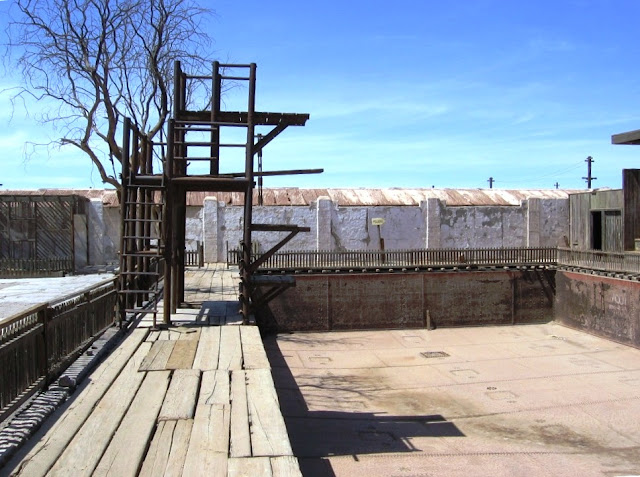 Why
Why
Click on photos to enlarge
Landing and on the taxi ride in from the airport (20+ minutes) the absence of vegetation is striking. There is literally nothing green, alive, growing out of the earth, except where planted and watered by people. Once in the city, there is more vegetation, but it is hardly verdant – landscaping is not one of the city’s strengths.
Our hotel, south of the city center and a block from the beach, was pleasant if unremarkable.
 The old city center, now including a pedestrian mall leading to the plaza, is full of old wood-frame buildings dating to the 19th and early 20th century.
The old city center, now including a pedestrian mall leading to the plaza, is full of old wood-frame buildings dating to the 19th and early 20th century.
It includes a good small regional museum that covers Iquique
At the end of the mall is the Plaza, with the Club Croata and the Casino Española at the far corner. The clubs were established by foreign mine owners and executives in the late 19th century. There is also a British Union Club.
…followed by a little rest by the fountain.
*******
One of the highlights of a trip to
Our first stop was at the Officina Santa Laura, just east of Humberstone on the map. The mines were called “offices” because the first mining was done by independents who blasted through the hard caliche to mine the softer deposits below, which they brought to the offices for sale. Later the offices became headquarters for mining and processing the sodium nitrate.

Humberstone and Santa Laura works contain over 200 former saltpeter works where workers from Chile,
The salitre processing plant
...and administrators’ living quarters.
A short distance further on is Humberstone, here showing the company town plaza.
From Humberstone we turned south on the Pan American Highway
Tamarugo plantation, FAO photo
Pampa de Tamaruga, tree plantations are the dark line on the horizon.
Our tour continued south to Cerro Pintados, site of a group of geoglyphs; figures etched into the desert pavement by clearing away the weathered surface gravel and exposing the lighter colored surface below. Similar glyphs, like the famous Nazca lines, exist in numerous locations in northern Chile and southern Peru
The geoglyphs with the deserted Cerro Pintado train station in the foreground.
From Pintado we turned North East, crossing the Pampa de Tamaruga, to the oasis of Pica, occupied by the Spanish in 1559. Today it has a few more than 2500 people, who live by cultivating citrus and other fruits and tourism. The lemon de Pica, Chile
On some days, lots of tourists.
On our way back to Iquique






















